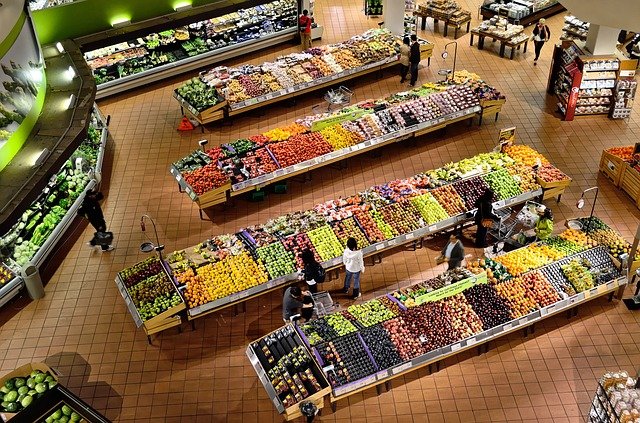By Tim Lambert
Early Shops
In the centre of Roman towns was a rectangular space called the Forum. It was lined by shops and by a public building called the Basilica. Markets were also held on the forum. In a large Roman town, other main streets were also lined with shops.
In Roman times shops did not have glass windows (glass was a luxury). Instead, they just had wooden shutters, which could be closed when the shop was shut. some shops sold imported goods while others, like bakeries, made goods on the premises. Usually, customers stood on the street outside the shop and the shopkeeper served them over a counter. Usually, the shopkeeper and his family lived in the building over or behind the shop. Rich women sent slaves to do the shopping.
In the Middle Ages, there were few permanent shops but every town had a market. Often if you wanted to buy or sell anything you went to the local market. Many towns also had annual fairs. Fairs were like markets but they were held only once a year. People would travel long distances to buy and sell at a fair.
Medieval shops were workshops where the customer could walk in. There were no glass windows.
In towns in the Middle Ages, there were a host of craftsmen such as carpenters, bakers, butchers, blacksmiths, bronze smiths, fletchers (arrow makers), bowyers (bow makers), potters, coopers, and barber-surgeons who both cut hair and pulled teeth. Often craftsmen of the same kind lived in the same street.
The number of shops grew in the 17th century. Meanwhile, glass grew much cheaper, and in the 18th century shops began to have glass windows. By the 18th century, there were many small shops in every town selling a wide variety of goods. Among the types of shops in the 18th century were shoemakers, drapers, milliners, haberdashers, bakers, butchers, grocers, fishmongers, booksellers, and gunsmiths.
Modern Shops
For wealthy women shopping was a popular pastime in the 19th century. In the late 19th century shopping arcades were built in many British towns. Also in the late 19th century department stores became common. In the early 20th century chain stores also became common although many shops were still family-owned.
In the 19th century, many annual fairs died out although markets continue to the present day. On the other hand, the first mail-order catalog was published in the USA in 1872.
In the 19th century, shops became more modern. Meanwhile, in 1852 a man named Francis Rolle invented a machine for making paper bags. (Useful for carrying groceries). In 1871 Margaret Knight invented a machine for making paper bags with flat bottoms. The cash register was invented in 1879 by James Ritty.
At the beginning of the 20th century, shop assistants worked long hours for low wages. However, the Shops Act 1911 made it compulsory for shop assistants in Britain to be given half a day off every week. Shops were made to close early one day a week.
The first supermarket opened in the USA in 1930. The shopping trolley was invented in 1937. The first supermarket in Britain opened in 1948.
In the 1950s shopping malls were built in the USA. The first shopping malls in Britain were built in the 1960s. The first was the Bull Ring Centre in Birmingham. Shopping malls are now common in towns and cities across Britain.
In 1966 the first credit card was introduced in Britain. Then in 1974, the barcode was first used in a supermarket in the USA. The first product scanned was chewing gum. The first time a barcode was used in a supermarket in the UK was in 1978. The first product scanned was a packet of teabags. In the early 21st century online shopping became common.

Last revised 2024